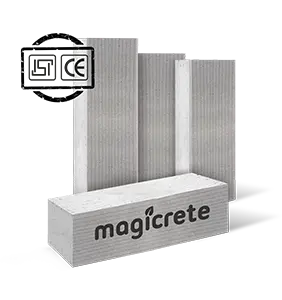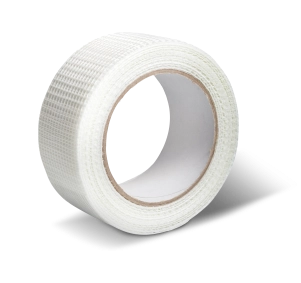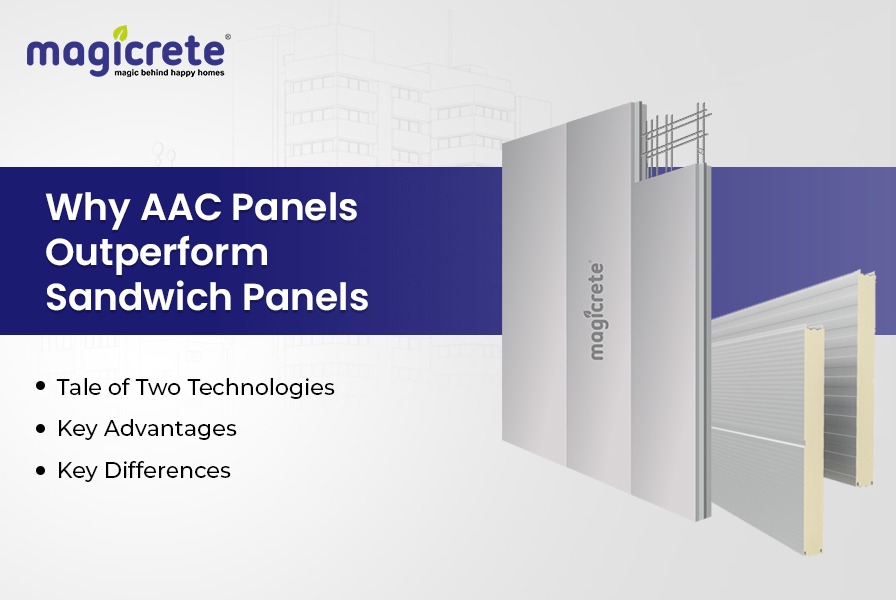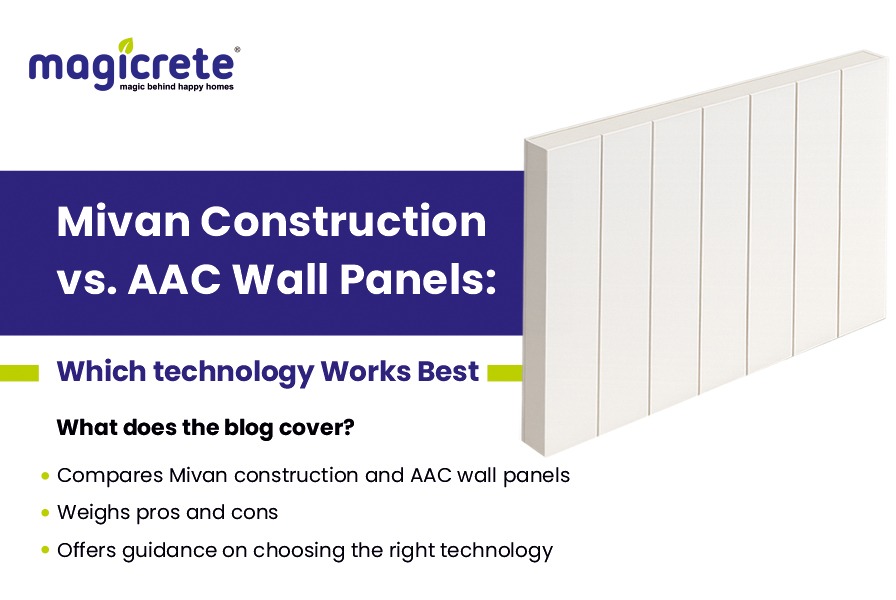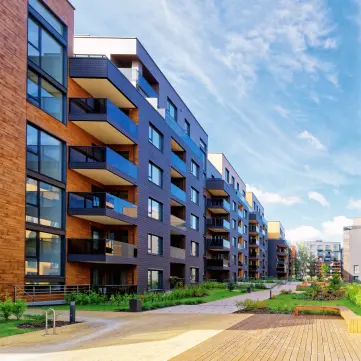AAC Wall Panels
Magicrete AAC Wall Panels is the quintessential green building material incorporating features long been desired by builders, engineers, and architects in the building construction industry. Their advantages surpass traditional construction methods, such as red clay bricks and concrete blocks, in several key aspects: strength, acoustics, thermal insulation, fire resistance, and installation efficiency. These panels, reinforced with corrosion-protected steel, strike a balance between lightweight design and heavy-duty performance.
Having achieved substantial success in global markets, AAC Wall Panel technology embodies the pinnacle of durable and high-quality construction, achieved within remarkably short timelines.
These panels boast the industry's highest thermal rating, boasting a K-value of 0.16 W/(m⋅K). Their cellular structure guarantees a well-insulated interior, ensuring cooler interiors during summer and warmer spaces in winter. Studies reveal a remarkable 30% reduction in air-conditioning bills, highlighting the panels' exceptional energy efficiency.
Resource efficiency remains a hallmark of Magicrete AAC Wall Panels, emphasizing minimal environmental impact. The closed air pockets within the panels create outstanding sound insulation, reaching an STC rating of 44 dB, effectively dampening external noise. Furthermore, their impressive 4-hour fire rating permits thinner wall sections, maximizing floor space for end-users. Available in full-height lengths from floor to ceiling, with varied thicknesses and a standard width of 600 mm, these panels offer versatility in design and application. Magicrete AAC wall panels' price are competitive in comparison to other walling materials available in the market.
Features

Corrosion Protected Steel Reinforced
AAC wall panels are corrosion-protected steel-reinforced, ensuring enduring and resilient performance in construction projects for sustained longevity.
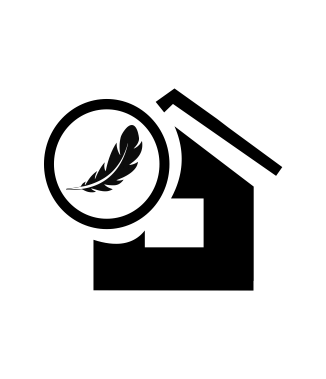
Lightweight
AAC wall panels have an exceptional lightweight design, minimizing structural load while maintaining robustness and ensuring long-lasting integrity for your building.

Thermal Insulation
AAC Wall Panels offer superior insulation with <0.16 W/m·K thermal conductivity, enabling up to 30% air conditioning energy savings in buildings across diverse climates.

Fire Resistant
AAC Wall Panels boast a unique cellular structure, offering a superior 4-hour fire rating. Their melting point exceeds 1600 degrees Celsius, ensuring exceptional fire resistance.

4x Faster Construction
Boasting 4 times faster construction than AAC blocks, each AAC Wall panel equals 15 blocks, slashing project timelines dramatically for swift and efficient construction.

No Coping/Bond Beam
AAC Wall Panels do not require coping or bond beams for wall heights up to 6 meters, offering exceptional structural stability. This eliminates additional reinforcement, reducing construction time, material usage, and labor costs.
Technical Specification
| PARAMETERS | SPECIFICATIONS |
|---|---|
| Weight | 55 kg/m2(75 mm) 70 kg/m2 (100 mm) |
| Density | ~ 600 Kg/m3 |
| Compressive Strength | >3.5 N/mm2 |
| Fire Resistance | 4 Hours (100 mm) |
| STC Rating | 43 db(100 mm) |
| MEP Installation difficulty level | Very Low |
| Coefficient of Thermal Expansion | 8x10-6/K |
| Thermal Conductivity (W/K-m) | 0.16 |
| Modulus of Elasticity | 2190 Mpa |
Walling Technology Comparison
| Parameters | AAC Wall Panels | Hollow Core Wall Panel | Dry Wall | Sandwich Wall |
|---|---|---|---|---|
 |
 |  |  |
|
Fire Resistance |
4 Hours (100mm) |
2 Hours (100 mm) |
1 Hour (100 mm) |
2 Hours (75 mm) |
Dry Density |
550-650 kg/m 3 |
1550 kg/m3 |
600-800 kg/m3 |
1000 Kg/m3 |
Sound Reduction Index (dB) |
43 dB (100mm) |
43 dB (100 mm) |
40 dB (100 mm) |
35 dB (100 mm) |
MEP Installation difficulty level |
Very Low |
High |
High |
High |
Weight |
55 kg/m2 70 kg/m2 |
110 kg/m2 (100 mm) |
20 kg/m2 |
54 kg/m2 |
Speed of Installation (1 Mason + 2 Helpers) |
40-50 m2/day |
40 m2/day |
40-50 m2/day |
20-30 m2/day |
Thermal Conductivity (W/K-m) |
0.16 |
0.4 |
0.25 |
0.21 |
Knowledge Base
Project Gallery
FAQs
Related Products
Related Blogs
Build Walls with Magicrete AAC Wall Panels
Revolutionize your wall construction with our high-performance AAC wall panels, the lightweight, durable, and thermally efficient choice trusted across India.
Magicrete AAC Wall Panels are setting a new benchmark in walling solutions. These panels offer faster installation, reduce structural load, and provide superior insulation. Whether you're constructing residential, commercial, or modular buildings, our panels help you build smarter, faster, and greener.
Why Choose Magicrete AAC Wall Panels?
Experience the next-generation walling solution with benefits that go beyond the basics:
- Light-weight yet heavy-duty: Light-weight design and each panel reinforced with corrosion-protected steel.
- Energy Efficient: Excellent thermal insulation lowers heating/cooling costs by 30%.
- Superior Strength & Durability: Robust structure with up to 4-hour fire resistance
- Faster construction: Available in full heights up to 4 m, these panels allow for up to 16 times faster construction.
- Cost-Effective: Reduce labor, structural costs, and long-term energy bills
- Eco-Conscious: Sustainable solution made from non-toxic, recyclable materials
Looking to compare? Don’t miss this blog: AAC Wall Panels vs. Sandwich Panels – A Detailed Comparison
Trusted Walling Solution Across Applications
Magicrete AAC Panels serve diverse needs, including:
- Homes – For sturdy interior/exterior walls that improve thermal comfort
- Commercial Buildings – Ideal for malls, offices, warehouses, and showrooms
- Boundary Walls – A modern, lighter alternative to RCC compound walls
- Modular Construction – Perfect for prefabricated buildings with quick turnaround
Still deciding between Mivan Construction and AAC Panels? Read: Mivan vs AAC Wall Panels – Explained
Wall Panel Pricing – Transparent & Competitive
Our AAC Wall Panels offer unmatched value. While AAC wall panel prices vary by size, thickness, and volume, Magicrete ensures transparent pricing across all regions.
We’re one of India's leading AAC wall panel manufacturers, with a nationwide team to ensure timely delivery and bulk pricing advantages.
Ready to Build Better with AAC Wall Panels?
Let Magicrete help you select the perfect wall panel solution. Request a quote, or speak to a product specialist today.
Talk to an Expert | AAC Wall Panel Near Me | Request Bulk Pricing
Discover More Insights: Expert Resources on AAC Wall Panel
Stay ahead in your construction journey with our latest insights. This section updates automatically as new articles are published.
🔗 AAC Wall Panels vs Sandwich Panels – Detailed Comparison
🔗 Mivan Construction vs AAC Wall Panels – Explained
🔗 AAC Block Jointing Mortar – Better Than Traditional Cement?








